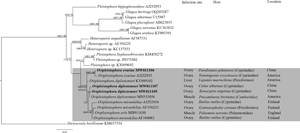Article contents
First report of Ovipleistophora ovariae and O. diplostomuri in China provides new insights into the intraspecific genetic variation and extends their distribution
Published online by Cambridge University Press: 28 October 2021
Abstract

Microsporidia of the genus Ovipleistophora are generally parasites of fishes and aquatic crustaceans. In the current study, Ovipleistophora diplostomuri and O. ovariae were firstly reported from Culter alburnus and Xenocypris argentea and Parabramis pekinensis, respectively. Both of them exclusively infected fish ovary and were morphologically, ultrastructurally and genetically characterized. Sporogony occurred in direct contact with the host cell cytoplasm and sporophorous vesicles were not observed for the new isolates of these two Ovipleistophora species. Spores of O. ovariae were for the first time observed to be dimorphic. Genetic analysis indicated that the genetic variation in the ITS and LSU sequences was distinct among between-host O. diplostomuri isolates. High sequence variation in ITS sequence suggests that it can be a reliable molecular marker to explore the population genetics of O. diplostomuri. This is the first report of these two Ovipleistophora species in China which extends their host and geographical range.
- Type
- Research Article
- Information
- Copyright
- Copyright © Qingdao Agricultural University, 2021. Published by Cambridge University Press.
References
- 7
- Cited by



